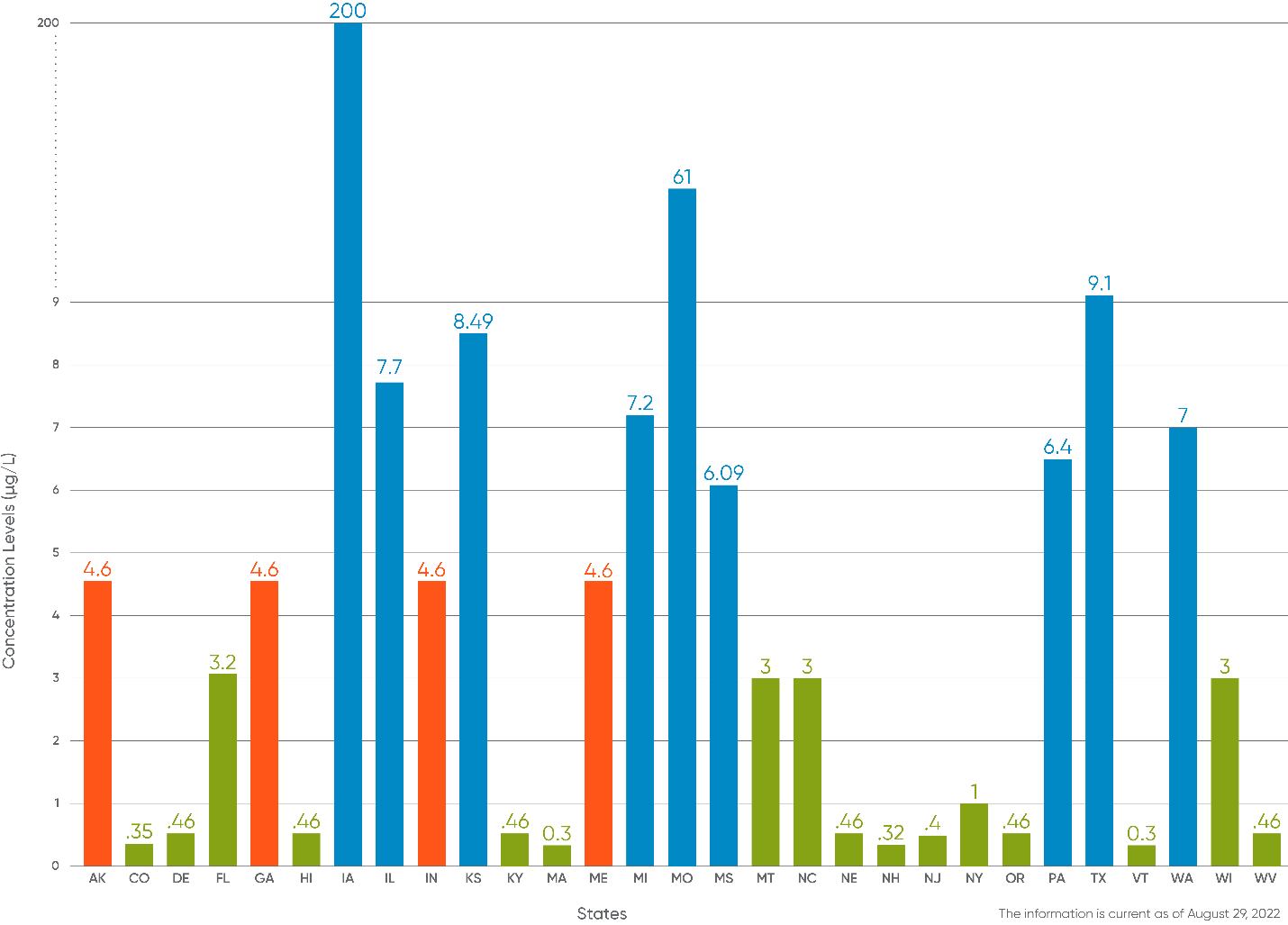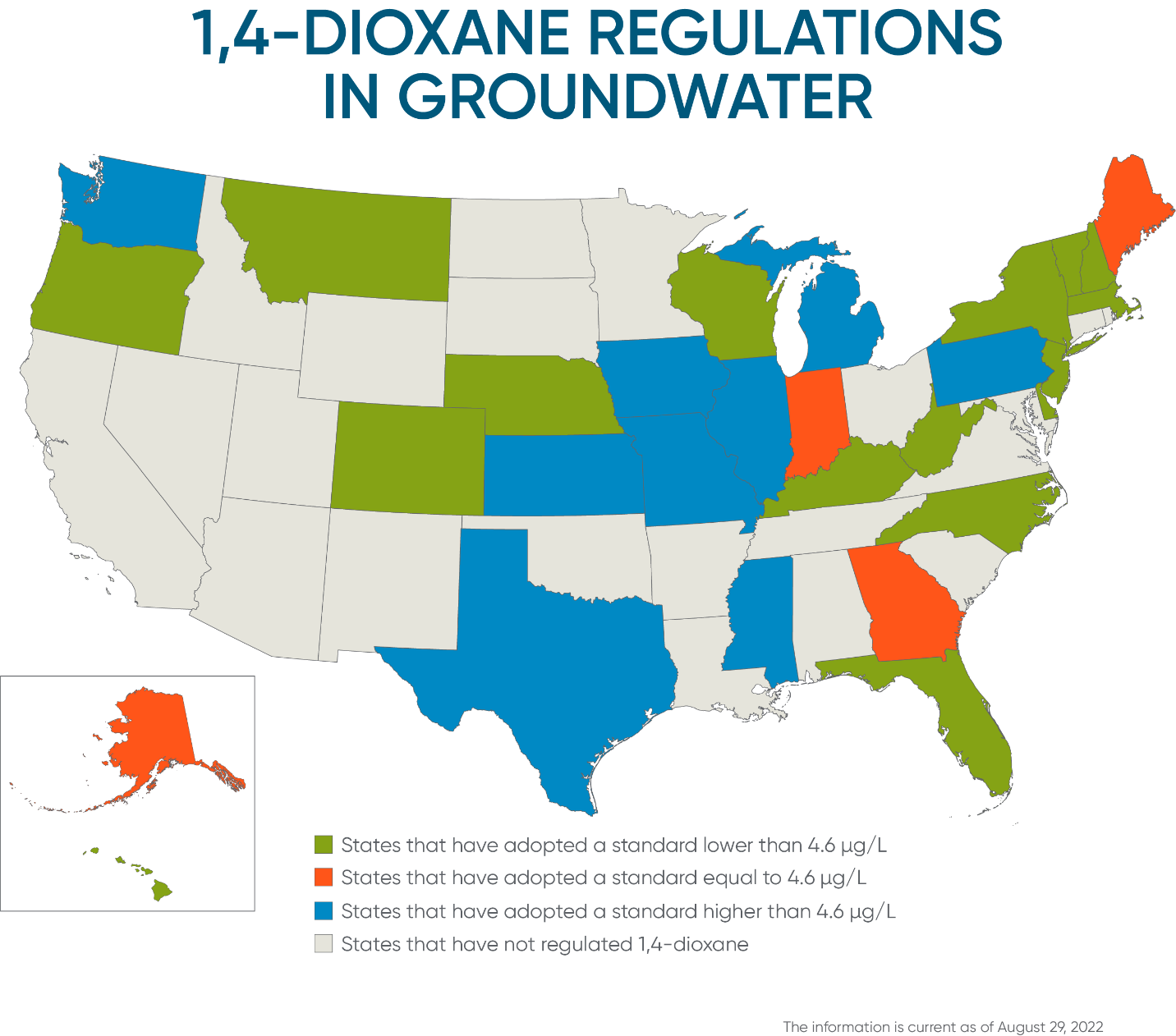Insights
1,4-Dioxane State Groundwater Regulations
Aug 31, 2022Summary
There is no federal drinking water standard for 1,4-dioxane, but as illustrated by a recent press release for the Industrial Excess Landfill Superfund Site in Ohio, the U.S. Environmental Protection Agency (EPA) and state environmental agencies have begun directing potentially responsible parties to conduct investigations to address the presence of 1,4-dioxane in drinking water and groundwater. Some of these investigations are conducted at previously closed sites at which the chemical had not been initially identified as a contaminant of concern. To protect the environment and avoid liability, any business in industries that use or produce this chemical must determine whether it needs to modify its operations to reduce or eliminate 1,4-dioxane.
This client alert surveys the remediation, guidance, and notification requirements for 1,4-dioxane in groundwater across the United States.
I. State Regulations and Guidance
The regulatory landscape for groundwater consists of an array of widely-varying state-promulgated standards and regulations. For example, the lowest allowable concentration is 0.3 µg/L (Massachusetts and Vermont), and the highest value is 200 µg/L (Iowa).

The map and chart are current as of August 29, 2022.
Some states, such as California, have established an advisory Groundwater Information Sheet for 1,4-dioxane. Other states, such as Connecticut, provided an advisory Technical Support Document for 1,4-dioxane (See Table 5).

State |
Concentration Level |
Type of Regulation |
Adoption Status |
|
|
|
Colorado |
0.35 µg/L |
Clean Up |
The Basic Standards for Groundwater Regulation
|
|
|
Delaware |
0.46 µg/L |
Advisory |
Hazardous Substance Cleanup Act Screening Level Table Guidance
|
|
|
Florida |
3.2 µg/L |
Advisory |
Groundwater and Surface Water Cleanup Target Levels and Florida Department of Health: 1,4-Dioxane Information
|
|
|
Hawaii |
0.46 µg/L |
Advisory |
Environmental Action Levels (See Table D-1a)
|
|
|
Kentucky |
0.67 µg/L |
Notification |
KRS 224.1-530 and EPA Regional Screening Levels
|
|
|
Massachusetts |
0.3 µg/L |
Advisory |
Massachusetts Contingency Plan (See pg. 197) and the Massachusetts Department of Environmental Protection’s 1,4-dioxane Fact Sheet
|
|
|
Montana |
3 µg/L |
Clean Up |
Montana Numeric Water Quality Standards
|
|
|
Nebraska |
0.46 µg/L |
Advisory |
Voluntary Cleanup Program Guidance Document Note: This requirement is only for the Voluntary Cleanup Program |
|
|
New Hampshire |
0.32 µg/L |
Clean Up |
New Hampshire Code of Administrative Rules Ch. Env-Or-600 and New Hampshire Department of Environmental Services 1,4-Dioxane Health Information Summary
|
|
|
New Jersey |
0.4 µg/L |
Notification |
Ground Water Quality Standards and the New Jersey Department of Environmental Protection’s 1,4-dioxane Frequently Asked Questions
|
|
|
New York |
1 µg/L (stated as 0.0010 mg/L) |
MCL |
Regulation and New York Department of Health Information Note: New York has proposed 0.35 µg/L for the GA class groundwater effluent standard |
|
|
North Carolina |
3 µg/L |
Clean Up |
Groundwater Quality Standards and the North Carolina Environmental Quality’s Groundwater Information
|
|
|
Oregon |
0.46 µg/L |
Advisory |
Risk-Based Concentrations for Individual Chemicals and Risk-Based Decision Making for the Remediation of Contaminated Sites Guidance
|
|
|
Vermont |
0.3 µg/L |
Guidance |
Groundwater Protection Rule and Strategy
|
|
|
West Virginia |
0.46 µg/L |
Advisory |
Voluntary Remediation and Redevelopment Rule Note: This requirement is only for the Voluntary Cleanup Program
|
|
|
Wisconsin |
3 µg/L |
Clean Up |
Groundwater Quality Regulations and the Wisconsin Department of Health Services 1,4-Dioxane Information Note: Wisconsin also has a “Preventive Action Limit” of 0.3 µg/L
|
|
|
Alaska |
4.6 µg/L |
Clean Up |
|
|
|
Georgia |
4.6 µg/L (stated as 0.0046 mg/L) |
Notification |
|
|
|
Indiana |
4.6 µg/L |
Advisory |
|
|
|
Maine |
4.6 µg/L |
Advisory |
Maine Department of Environmental Protection Remedial Action Guidelines
|
|
|
Illinois |
7.7 µg/L (stated as 0.0077 mg/L) |
Notification |
|
|
|
Iowa |
200 µg/L (stated as 0.2 mg/L) |
Advisory |
|
|
|
Kansas |
8.49 µg/L (stated as 0.00849 mg/L) |
Advisory |
Risk-Based Standards (See App. A) |
|
|
Michigan |
7.2 µg/L |
Clean Up |
Michigan Department of Environmental Quality Environmental Contamination Response Activity
|
|
|
Mississippi |
6.09 µg/L |
Advisory |
Risk Evaluation Procedures for Voluntary Cleanup and Redevelopment of Brownfield Sites Note: This requirement is only for the Voluntary Cleanup Program
|
|
|
Missouri |
61 ug/L (stated as .061 mg/L) |
Advisory |
Missouri Risk-Based Corrective Action Technical Guidance (See Table B-1) |
|
|
Pennsylvania |
6.4 µg/L |
Notification |
Regulation and Appendix Note: This requirement is only for the Voluntary Cleanup Program
|
|
|
Texas |
9.1 µg/L (stated as 0.0091 mg/L) |
Clean Up |
Risk Reduction Rule (See Table 3 of the March 2022 PCL Table)
|
|
|
Washington |
7.0 µg/L |
Clean Up |
|
States with No 1,4-dioxane Groundwater Regulations or Enforceable Guidance (as of the date of publication):
Alabama, Arizona, Arkansas, California, Connecticut, Idaho, Louisiana, Maryland, Minnesota, New Mexico, North Dakota, Ohio, Oklahoma, Rhode Island, South Carolina, South Dakota, Tennessee, Utah, Virginia, and Wyoming
Key:
|
Notification |
A corporate representative may have to inform an appropriate state official that a groundwater source contributing to a public drinking water supply is above the limit. |
|
Advisory |
The state establishes recommended concentration limits for 1,4-dioxane, but no notification or other action is required if concentrations exceed the recommended limits. |
|
Clean Up |
Investigation and remediation is usually required when concentration levels exceed the requirement. Clean up standards are usually expressed by values that identify specific clean up criteria. |
|
MCL |
MCLs establish the maximum amount of 1,4-dioxane that can be present in water concentrations. Treatment facilities that supply drinking water (by using groundwater supplies) must ensure that these limits are met by treating and filtering the water, and also by limiting the discharge of 1,4-dioxane through permits. |
II. Conclusion
The regulation of 1,4-dioxane in groundwater will continue over the next several years as additional research is conducted on potential health impacts, and as regulators at both the federal and state levels develop a deeper understanding of the prevalence of 1,4-dioxane in groundwater.
If you have any questions regarding 1,4-dioxane, please contact Phil Karmel (212-541-2311), John Kindschuh (314-259-2313), or Erin Brooks (314-259-2393).
Related Practice Areas
-
Environment
-
PFAS Team





